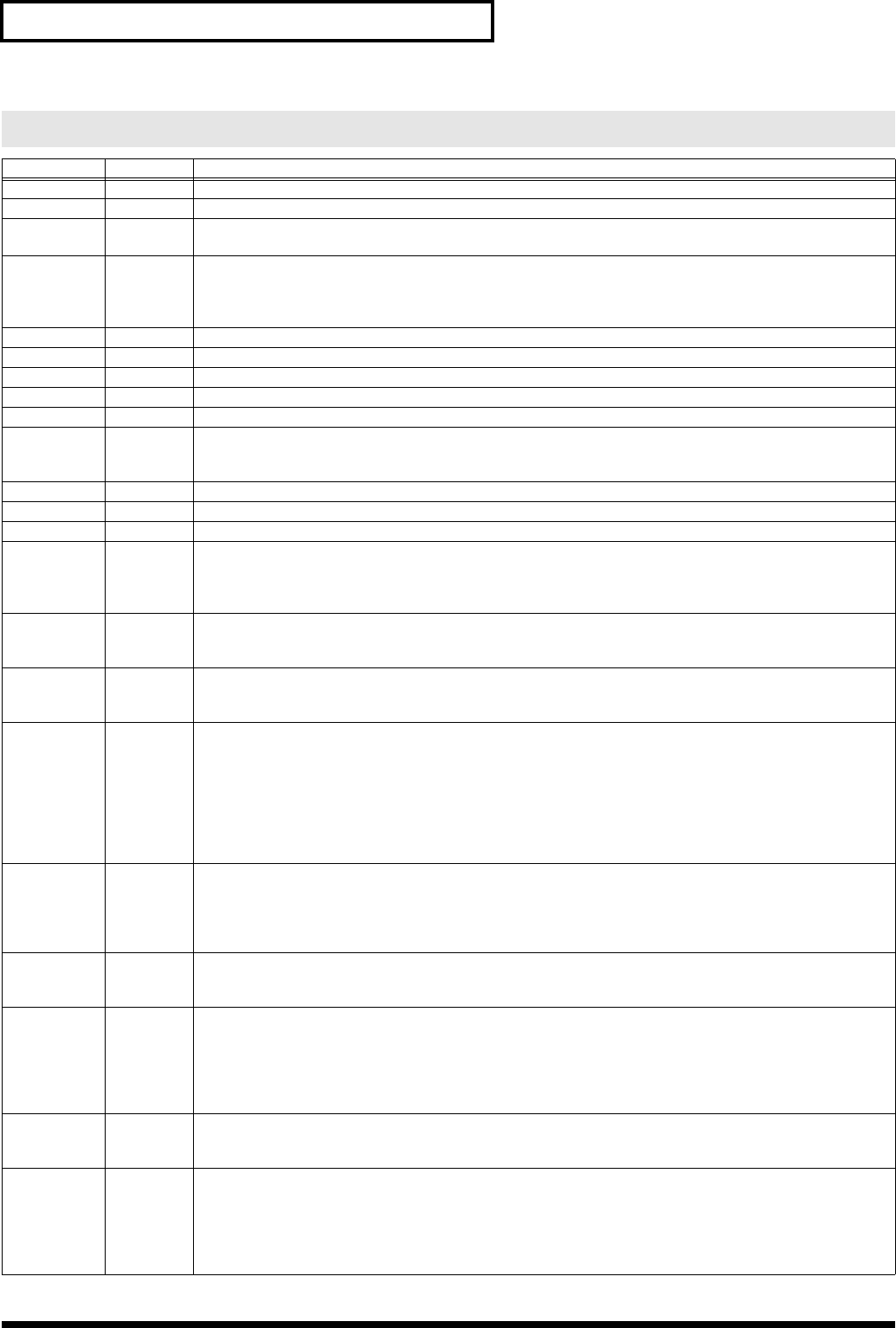
18
Performance Functions and Effects
Performance Parameters
Parameter
Range Explanation
Kbd Velo Sw
OFF, ON Specifies whether the loudness of the notes you play from the keyboard will be fixed (OFF) or not (ON).
Kbd Velocity 1–127 Specifies the loudness of each note when the above “Kbd Velo Sw” is OFF.
Split Point 36–96 Specifies the split point (the key at which the keyboard will be divided) used in Split mode. This will be the low-
est note of the Upper Part.
60
corresponds to
C4
.
Oct Main -4–+4 Raises or lowers the pitch in steps of one octave for Main mode, the Upper Part of Split mode, or the first Tone
of Dual mode.
*
In the case of a drum set, this does not transpose the pitch; rather, it shifts the set of drum/percussion sounds
that are assigned to the keyboard.
Oct Dual -4–+4 Raises or lowers the pitch in steps of one octave for the second Tone of Dual mode.
Oct Split -4–+4 Raises or lowers the pitch in steps of one octave for the Lower Part of Split mode.
Vol Main 0–127 Adjusts the volume for Main mode, the Upper Part of Split mode, or the first Tone of Dual mode.
Vol Dual 0–127 Adjusts the volume for the second Tone of Dual mode.
Vol Split 0–127 Adjusts the volume for the Lower Part of Split mode.
Vol ChordBs 0–127 Adjusts the Chord Bass volume.
When [BACKING TRACK] is lit and the backing is stopped, the bass will sound according to the chord you play
in the left hand.
Vol Drum 0–127 Adjusts the volume of the music style’s drum part.
Vol Bass 0–127 Adjusts the volume of the music style’s bass part.
Vol Backing 0–127 Adjusts the volume of the music style’s backing parts 1–6.
Pan Main RND,
L63–0–R63
Adjusts the panning (left/right stereo position) for Main mode, the Upper Part of Split mode, or the first Tone of
Dual mode.
RND
: The pan position will change randomly for each note.
L63–0–R63
: Values beginning with “
L
” place the sound at the left,
0
at the center, and “
R
” at the right.
Pan Dual RND,
L63–0–R63
Adjusts the panning (left/right stereo position) for the second Tone of Dual mode.
RND
: The pan position will change randomly for each note.
L63–0–R63
: Values beginning with “
L
” place the sound at the left,
0
at the center, and “
R
” at the right.
Pan Split RND,
L63–0–R63
Adjusts the panning (left/right stereo position) for the Lower Part of Split mode.
RND
: The pan position will change randomly for each note.
L63–0–R63
: Values beginning with “
L
” place the sound at the left,
0
at the center, and “
R
” at the right.
Chord Mode OFF,
MODE 1,
MODE 2
This lets you use simple fingering to specify a chord without having to play all the notes in the chord.
OFF
: The chord will consist of only the note(s) you play on the keyboard in the Lower Part.
MODE 1
: You can play chords as described in "Chord Intelligence" (p. 41).
MODE 2
: You can specify chords in the following four ways.
Major chords
: Play the root note of the chord
Minor chords
: Play the root note and the black key located at its left
Seventh chords
: Play the root note and the white key located at its left
Minor seventh chords
: Play the root note + black key at left + white key at left
Backing
Hold
OFF, ON Selects how the backing part will sound.
OFF
: When you take your hand off the left side of the keyboard, instrumental sounds other than the drums of
the backing part will stop; only the rhythm part will continue sounding.
ON
: The chord you played in the left hand will be remembered. The backing will continue playing with that
chord until you play another chord.
Bass Inv OFF, ON Specifies how Chord Bass will be sounded.
OFF
: The root note of the chord you play will sound.
ON
: The lowest note of the chord you play will sound.
ScaleType EQUAL,
ARABIC
Selects the scale setting.
EQUAL
(Equal temperament): This is the method of tuning that is most widely used in Western music, in which
the octave is divided into twelve equal steps.
ARABIC
(Arabic temperament): Compared to equal temperament, E and B are half a semitone low, and C#, F#,
and Ab are half a semitone high. The intervals G–B, C–E, F–Ab, Bb–C#, and
Eb–F3 are a neutral third (between a major third and minor third).
Scale Mode MAIN,
ALL
Specifies the part(s) to which the Scale setting will apply.
MAIN
: The scale setting applies to Main mode, the Upper Part of Split mode, and the first Tone of Dual mode.
ALL
: The scale setting applies to all parts.
Scale C–B -64–+63 As an alternative to the temperament commonly used in Western music, you can adjust the pitch of each note to
create temperaments used in other musical cultures or historical periods (e.g., Oriental temperaments, or tem-
peraments used in the Baroque era).
You can adjust the pitch of each note in the octave (
C
,
C#
,
D
,
Eb
,
E
,
F
,
F#
,
G
,
Ab
,
A
,
Bb
,
B
). These settings are
applied to every note of the same name (i.e., the
C
of each octave, the
C#
of each octave, etc.) Most often, the pitch
is adjusted one quarter tone upward or downward, so you will select a value of
50
or
-50
.
GW-7_e.book 18 ページ 2005年2月16日 水曜日 午前8時48分


















